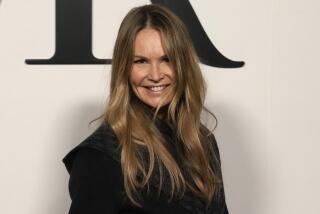Campbell Has Energy for Role
- Share via
Edna Campbell walked tall and straight into the Cordelia Knott Center for Wellness in Orange on Friday, looking every inch like the professional athlete she is, energetic and robust.
Campbell, who plays basketball for the WNBA’s Sacramento Monarchs, was there to visit people she hopes will soon be described just like her: a breast cancer survivor.
Campbell, 35, who returned to the WNBA last year after sitting out all but one game in the 2002 season to regain her health, spent the afternoon signing autographs and delivering a message patients often hear but are sometimes tentative to embrace: that cancer does not have to be a death sentence; that with treatment and therapy they can resume their lives as she has.
“I’m thankful for being diagnosed with breast cancer,” Campbell said. “It’s given me the opportunity to touch other people’s lives.”
There are plenty to touch.
“In Orange County, one of every seven women over their lifetime will develop breast cancer,” said Dr. Paul Coluzzi, an internist and oncologist at the center. “In Los Angeles County it’s about one of every eight women. If you take it a step further, a significant number of people, including spouses and family, are going to know someone with breast cancer.”
Campbell first became ill on Feb. 22, 2002, while playing basketball in Italy. She had a virus that didn’t seem to go away. Her flu-like symptoms and a low white blood cell count prompted her to visit a doctor. She returned to Pittsburgh for a series of tests, including a mammogram, and learned of the cancer. She said she did not feel the lump in her breast that was discovered during the mammogram.
“Prior to my diagnosis I was oblivious to breast cancer and that it was hitting women in proportions that it is,” said Campbell, who had no family history of the disease. “It was the furthest thing from my mind.”
According to Coluzzi, the exact causes of breast cancer are not known. It is considered uncommon for women under 35, but the risk increases with age. Most breast cancer diagnosed in women occurs after age 50, and the risk increases another notch for women after 60. White females develop the cancer more often than African American and Asian females. Also, 1% to 2% of males are diagnosed with the disease.
Indicators for women include a family history of breast cancer, late child bearing, longtime exposure to estrogen, breast density and radiation therapy.
Doctors cannot yet explain why one woman gets the cancer and another doesn’t, but they are sure the cancer isn’t caused through bumping, bruising or touching of the breast.
“Most women that we see here at the center show no actual risk factors,” said Coluzzi, who added the center handles about 300 new cases a year.
“Some people we see have a simple cancer that needs just surgery or radiation. Others may require chemotherapy or hormonal treatments. But about 25% of the women who’ve been diagnosed with the cancer in their lifetime will develop another breast cancer.”
Campbell underwent surgery to have a small lump removed. Next came chemotherapy and radiation treatments. She would later develop anemia, a common side effect of chemotherapy in which the body does not have enough red blood cells. Anemia can cause debilitating fatigue, and it often left Campbell with little energy during her return to the WNBA last season.
Only now is she feeling healthy and strong.
“I’m ready to get out on the court and do my job, live my life, and do everything I can to generate breast health awareness. Just be a ray of hope for whomever I may be that for,” Campbell said.
She provided reinforcement for patients such as Stacy Brown, an Orange resident and mother of three who was diagnosed with breast cancer in December and began chemotherapy in February.
“It’s great to see that once I’m through with this I can be as healthy and vibrant as she is now,” Brown said.
More to Read
Go beyond the scoreboard
Get the latest on L.A.'s teams in the daily Sports Report newsletter.
You may occasionally receive promotional content from the Los Angeles Times.










